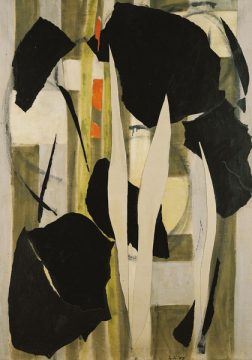T.J. Clark at the LRB:
 The Prophecy pictures were made in tragic circumstances. By 1956 Krasner’s marriage to Jackson Pollock was all but broken. In August that year, while Krasner was in Europe, Pollock’s Oldsmobile came off the road at speed, killing himself and Edith Metzger, a friend of his lover, Ruth Kligman. Kligman survived the crash. The paintings Krasner made in response to the horror – and this is almost always her strength – are deeply engaged with other people’s imagery. Fighting with De Kooning’s Woman, as she does throughout – fighting and feeding on his colour, the scale and shape of his Cubist body parts, his bad faith fascination with Marilyn Monroe gorgeousness (bad faith because his irony is so obviously an alibi for gloating) – is her way of discovering what ‘woman’, that terrifying abstraction, meant for her. Out of the engagement comes the originality. Dripping paint, for example, was already a tired Ab Ex trademark by 1956, by no means De Kooning’s exclusive property. But no one had made dripped paint so unlovely, so impatient and passionless, as Krasner did the pinks and whites in Birth. (The tone of the title is undecidable.) For the fight with De Kooning to end in victory, other painters’ weaponry had to be taken out of the closet, some of it distinctly old-fashioned. Krasner was never up to date. Three in Two, for example, evokes explicitly, and not just in its title, the savage Jungian splitting and swapping of genders that Pollock had gone in for a decade earlier, during the time of Two and Male and Female. Behind those paintings lay Picasso, specifically Les Demoiselles d’Avignon. Krasner was monstrously confident that she could mobilise this big machinery without in the least repeating its moves – or rather, that she could use the moves to deliver an entirely new, and dreadful, sense of closeness and inhumanity. Embrace, for example, is Les Demoiselles churned into viscera.
The Prophecy pictures were made in tragic circumstances. By 1956 Krasner’s marriage to Jackson Pollock was all but broken. In August that year, while Krasner was in Europe, Pollock’s Oldsmobile came off the road at speed, killing himself and Edith Metzger, a friend of his lover, Ruth Kligman. Kligman survived the crash. The paintings Krasner made in response to the horror – and this is almost always her strength – are deeply engaged with other people’s imagery. Fighting with De Kooning’s Woman, as she does throughout – fighting and feeding on his colour, the scale and shape of his Cubist body parts, his bad faith fascination with Marilyn Monroe gorgeousness (bad faith because his irony is so obviously an alibi for gloating) – is her way of discovering what ‘woman’, that terrifying abstraction, meant for her. Out of the engagement comes the originality. Dripping paint, for example, was already a tired Ab Ex trademark by 1956, by no means De Kooning’s exclusive property. But no one had made dripped paint so unlovely, so impatient and passionless, as Krasner did the pinks and whites in Birth. (The tone of the title is undecidable.) For the fight with De Kooning to end in victory, other painters’ weaponry had to be taken out of the closet, some of it distinctly old-fashioned. Krasner was never up to date. Three in Two, for example, evokes explicitly, and not just in its title, the savage Jungian splitting and swapping of genders that Pollock had gone in for a decade earlier, during the time of Two and Male and Female. Behind those paintings lay Picasso, specifically Les Demoiselles d’Avignon. Krasner was monstrously confident that she could mobilise this big machinery without in the least repeating its moves – or rather, that she could use the moves to deliver an entirely new, and dreadful, sense of closeness and inhumanity. Embrace, for example, is Les Demoiselles churned into viscera.
more here.
